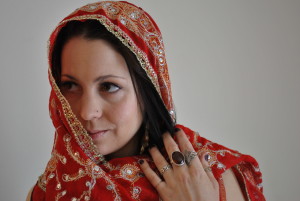This semester, I’m teaching a class I designed on Body Art. It’s cross-listed in anthropology and gender, women’s, and sexuality studies, but it’s really a folklore class (surprise, surprise). One concept that my students have really latched onto is the idea of audience, and the first audience for any expressive display being the self.

Me wearing a shawl from Kamakhya Temple in Assam, India. Photo by Walking Contradiction Photography.
The main text we’re reading is The Grace of Four Moons: Dress, Adornment, and the Art of the Body in Modern India, by Pravina Shukla, a professor of folklore at Indiana University (who was also one of my mentors while I was there for my PhD). I assigned this book for a few reasons: it’s well-written and is on the whole a beautiful book, it lays out the study of body art as a genre of material culture quite clearly, and it foregrounds the study of both daily dress and special occasion wear.
A lot of students came to my body art class expecting to spend the whole semester talking about tattoos and other permanent or extreme body mods. We will certainly discuss those things, but I’m also trying to give my students vocabulary and concepts for studying the daily clothing choices that surround them. I’m assigning a handful of fieldwork projects, for example, that could include looking at tattoos and piercings, but will mostly be about observing the clothing of people around them. I like to think that I’m giving them tools to critically interpret the visual culture of clothing, in order to perhaps be a bit more savvy about brands and advertising and the commodification of bodies.
Body image is one topic that I’m looking forward to discussing with my students. We’ve talked about the idea that when you get dressed in the morning, you’re the first audience for your stylistic choices. Your entire life history, your sense of body image, your self-esteem, your struggles with your weight… those all are foregrounded when you decide what to wear when dressing to go out. This is one area where my class design dovetails nicely with gender studies: women and men get radically different social messages about what’s appropriate to wear, and what’s considered “normal” for outfits and attractiveness.
One thing I’ve noticed when thinking about audience and body image in conjunction is that we are usually harder on ourselves than others are. If I’m trying on an outfit, I’ll probably notice imperfections and inconsistencies that no one else would see. I’m seeing the accumulation of my years of body image anxiety that no one else sees when they look at me, since I manage to appear outwardly confident (sometimes intimidatingly so). If I am my first audience, I am truly a harsh critic… and while I haven’t done the research on this yet (though now I really want to!) I’m guessing this trend is true of many other folks. It’s probably gendered, too, from what I gather based on informal conversations with friends and fellow dancers.
So if the self is the first audience, I wonder: do we owe it to ourselves to be kinder audiences? Do we seek fault with ourselves so that we can beat others to it? When do we allow ourselves to see the most beauty in our self image? Are there links between allowing ourselves creative freedom in body adornment (c’mon, who else still plays dress-up?) and feeling more satisfied with our body image?
The semester’s only just begun, so I hope to dig a bit deeper into these topics with my students. But I also hope to start some dialogue with the wider world, because we all could stand to be a little kinder to ourselves, and to see ourselves as beautiful.
Tags: body, body art, body image, folklore

No comments
Comments feed for this article
Trackback link: http://jeanajorgensen.com/wordpress/the-self-is-the-first-audience/trackback/